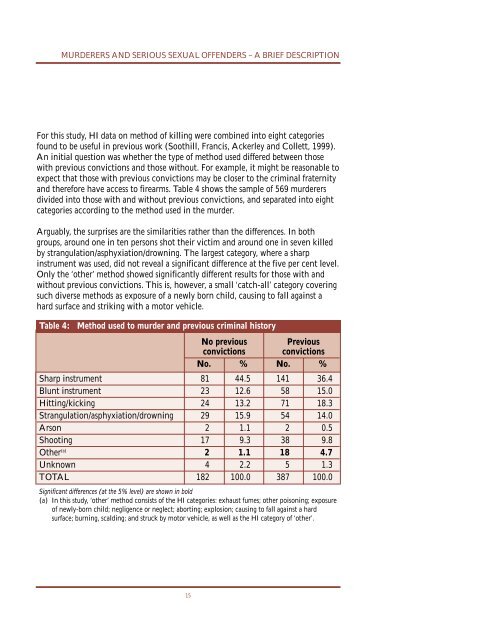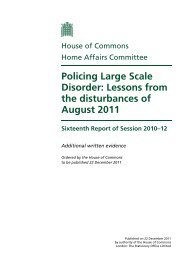Murder and Serious Sexual Assault - Lancaster EPrints - Lancaster ...
Murder and Serious Sexual Assault - Lancaster EPrints - Lancaster ...
Murder and Serious Sexual Assault - Lancaster EPrints - Lancaster ...
You also want an ePaper? Increase the reach of your titles
YUMPU automatically turns print PDFs into web optimized ePapers that Google loves.
MURDERERS AND SERIOUS SEXUAL OFFENDERS – A BRIEF DESCRIPTION<br />
For this study, HI data on method of killing were combined into eight categories<br />
found to be useful in previous work (Soothill, Francis, Ackerley <strong>and</strong> Collett, 1999).<br />
An initial question was whether the type of method used differed between those<br />
with previous convictions <strong>and</strong> those without. For example, it might be reasonable to<br />
expect that those with previous convictions may be closer to the criminal fraternity<br />
<strong>and</strong> therefore have access to firearms. Table 4 shows the sample of 569 murderers<br />
divided into those with <strong>and</strong> without previous convictions, <strong>and</strong> separated into eight<br />
categories according to the method used in the murder.<br />
Arguably, the surprises are the similarities rather than the differences. In both<br />
groups, around one in ten persons shot their victim <strong>and</strong> around one in seven killed<br />
by strangulation/asphyxiation/drowning. The largest category, where a sharp<br />
instrument was used, did not reveal a significant difference at the five per cent level.<br />
Only the ‘other’ method showed significantly different results for those with <strong>and</strong><br />
without previous convictions. This is, however, a small ‘catch-all’ category covering<br />
such diverse methods as exposure of a newly born child, causing to fall against a<br />
hard surface <strong>and</strong> striking with a motor vehicle.<br />
Table 4: Method used to murder <strong>and</strong> previous criminal history<br />
No previous Previous<br />
convictions convictions<br />
No. % No. %<br />
Sharp instrument 81 44.5 141 36.4<br />
Blunt instrument 23 12.6 58 15.0<br />
Hitting/kicking 24 13.2 71 18.3<br />
Strangulation/asphyxiation/drowning 29 15.9 54 14.0<br />
Arson 2 1.1 2 0.5<br />
Shooting 17 9.3 38 9.8<br />
Other (a) 2 1.1 18 4.7<br />
Unknown 4 2.2 5 1.3<br />
TOTAL 182 100.0 387 100.0<br />
Significant differences (at the 5% level) are shown in bold<br />
(a) In this study, ‘other’ method consists of the HI categories: exhaust fumes; other poisoning; exposure<br />
of newly-born child; negligence or neglect; aborting; explosion; causing to fall against a hard<br />
surface; burning, scalding; <strong>and</strong> struck by motor vehicle, as well as the HI category of ‘other’.<br />
15
















